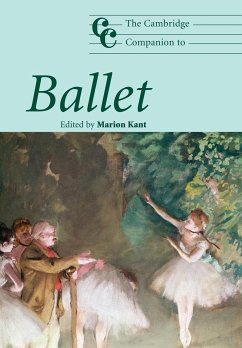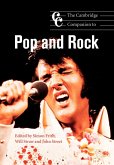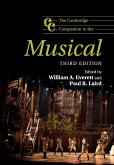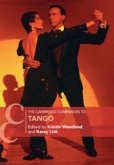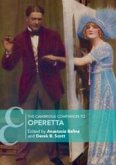- Broschiertes Buch
- Merkliste
- Auf die Merkliste
- Bewerten Bewerten
- Teilen
- Produkt teilen
- Produkterinnerung
- Produkterinnerung
This Companion traces the evolution of ballet as a theatrical art from the fifteenth to the end of the twentieth century. An international team of writers discuss important and interesting aspects of a much beloved art form that has many friends but few historical reference books.
Andere Kunden interessierten sich auch für
![The Cambridge Companion to Pop and Rock The Cambridge Companion to Pop and Rock]() Simon Frith / Will Straw / John Street (eds.)The Cambridge Companion to Pop and Rock36,99 €
Simon Frith / Will Straw / John Street (eds.)The Cambridge Companion to Pop and Rock36,99 €![The Cambridge Companion to Metal Music The Cambridge Companion to Metal Music]() The Cambridge Companion to Metal Music24,99 €
The Cambridge Companion to Metal Music24,99 €![The Cambridge Companion to the Electric Guitar The Cambridge Companion to the Electric Guitar]() The Cambridge Companion to the Electric Guitar34,99 €
The Cambridge Companion to the Electric Guitar34,99 €![The Cambridge Companion to the Musical The Cambridge Companion to the Musical]() The Cambridge Companion to the Musical34,99 €
The Cambridge Companion to the Musical34,99 €![The Cambridge Companion to Film Music The Cambridge Companion to Film Music]() The Cambridge Companion to Film Music32,99 €
The Cambridge Companion to Film Music32,99 €![The Cambridge Companion to Tango The Cambridge Companion to Tango]() The Cambridge Companion to Tango38,99 €
The Cambridge Companion to Tango38,99 €![The Cambridge Companion to Operetta The Cambridge Companion to Operetta]() The Cambridge Companion to Operetta42,99 €
The Cambridge Companion to Operetta42,99 €-
-
-
This Companion traces the evolution of ballet as a theatrical art from the fifteenth to the end of the twentieth century. An international team of writers discuss important and interesting aspects of a much beloved art form that has many friends but few historical reference books.
Hinweis: Dieser Artikel kann nur an eine deutsche Lieferadresse ausgeliefert werden.
Hinweis: Dieser Artikel kann nur an eine deutsche Lieferadresse ausgeliefert werden.
Produktdetails
- Produktdetails
- Cambridge Companions to Music
- Verlag: Cambridge University Press
- Seitenzahl: 396
- Erscheinungstermin: 19. Mai 2011
- Englisch
- Abmessung: 244mm x 170mm x 22mm
- Gewicht: 834g
- ISBN-13: 9780521539869
- ISBN-10: 0521539862
- Artikelnr.: 22549372
- Herstellerkennzeichnung
- Libri GmbH
- Europaallee 1
- 36244 Bad Hersfeld
- gpsr@libri.de
- Cambridge Companions to Music
- Verlag: Cambridge University Press
- Seitenzahl: 396
- Erscheinungstermin: 19. Mai 2011
- Englisch
- Abmessung: 244mm x 170mm x 22mm
- Gewicht: 834g
- ISBN-13: 9780521539869
- ISBN-10: 0521539862
- Artikelnr.: 22549372
- Herstellerkennzeichnung
- Libri GmbH
- Europaallee 1
- 36244 Bad Hersfeld
- gpsr@libri.de
Marion Kant teaches at the University of Pennsylvania.
Foreword Ivor Guest; Chronology; Introduction Marion Kant; Part I. From the Renaissance to the Baroque: Royal Power and Worldly Display: 1. The early dance manuals and the structure of ballet: a basis for Italian, French and English ballet Jennifer Nevile; 2. Ballet de Cour Marina Nordera; 3. English masques Barbara Ravelhofer; 4. The Baroque body Mark Franko; Part II. The Eighteenth Century: Revolutions in Technique and Spirit: 5. Choreography and narrative: the ballet d'action of the eighteenth century Dorion Weickmann; 6. The rise of ballet technique and training: the professionalism of an art form Sandra Noll Hammond; 7. The making of history: John Weaver and the enlightenment Tim Blanning; 8. Jean-Georges Noverre: dance and reform Judith Chazin-Benahum; 9. The French Revolution and its spectacles Inge Baxmann; Part III. Romantic Ballet: Ballet is a Woman: 10. Romantic ballet in France: 1830-50 Sarah Davis Cordova; 11. Deadly sylphs and decent mermaids: the women in the Danish romantic world of August Bournonville Anne Middlebo Christensen; 12. The orchestra as translator: French nineteenth-century ballet Marian E. Smith; 13. Russian ballet in the age of Petipa Lynn Garafola; 14. Opening the door to a fairy tale world: Tchaikovsky's ballet music Thérèse Hurley; 15. The romantic ballet and its critics: dance goes public Lucia Ruprecht; 16. The soul of the shoe Marion Kant; Part IV. The Twentieth Century: Tradition Becomes Modern: 17. The ballet avant-garde I: the Ballet Suedois and its modernist concept Erik Näslund; 18. The ballet avant-garde II: the 'new' ballet: Russian and Soviet dance in the twentieth century Tim Scholl; 19. George Balanchine Matilda Butkas; 20. Balanchine and the deconstruction of classicism Juliet Bellow; 21. The Nutcracker: a cultural icon Jennifer Fisher; 22. From Swan Lake to Red Girl's Regiment: ballet's sinicisation Yangwen Zhen; 23. Giselle in a Cuban accent Lester Tome; 24. European ballet in the age of ideologies Marion Kant.
Foreword Ivor Guest; Chronology; Introduction Marion Kant; Part I. From the
Renaissance to the Baroque: Royal Power and Worldly Display: 1. The early
dance manuals and the structure of ballet: a basis for Italian, French and
English ballet Jennifer Nevile; 2. Ballet de Cour Marina Nordera; 3.
English masques Barbara Ravelhofer; 4. The Baroque body Mark Franko; Part
II. The Eighteenth Century: Revolutions in Technique and Spirit: 5.
Choreography and narrative: the ballet d'action of the eighteenth century
Dorion Weickmann; 6. The rise of ballet technique and training: the
professionalism of an art form Sandra Noll Hammond; 7. The making of
history: John Weaver and the enlightenment Tim Blanning; 8. Jean-Georges
Noverre: dance and reform Judith Chazin-Benahum; 9. The French Revolution
and its spectacles Inge Baxmann; Part III. Romantic Ballet: Ballet is a
Woman: 10. Romantic ballet in France: 1830-50 Sarah Davis Cordova; 11.
Deadly sylphs and decent mermaids: the women in the Danish romantic world
of August Bournonville Anne Middlebo Christensen; 12. The orchestra as
translator: French nineteenth-century ballet Marian E. Smith; 13. Russian
ballet in the age of Petipa Lynn Garafola; 14. Opening the door to a fairy
tale world: Tchaikovsky's ballet music Thérèse Hurley; 15. The romantic
ballet and its critics: dance goes public Lucia Ruprecht; 16. The soul of
the shoe Marion Kant; Part IV. The Twentieth Century: Tradition Becomes
Modern: 17. The ballet avant-garde I: the Ballet Suedois and its modernist
concept Erik Näslund; 18. The ballet avant-garde II: the 'new' ballet:
Russian and Soviet dance in the twentieth century Tim Scholl; 19. George
Balanchine Matilda Butkas; 20. Balanchine and the deconstruction of
classicism Juliet Bellow; 21. The Nutcracker: a cultural icon Jennifer
Fisher; 22. From Swan Lake to Red Girl's Regiment: ballet's sinicisation
Yangwen Zhen; 23. Giselle in a Cuban accent Lester Tome; 24. European
ballet in the age of ideologies Marion Kant.
Renaissance to the Baroque: Royal Power and Worldly Display: 1. The early
dance manuals and the structure of ballet: a basis for Italian, French and
English ballet Jennifer Nevile; 2. Ballet de Cour Marina Nordera; 3.
English masques Barbara Ravelhofer; 4. The Baroque body Mark Franko; Part
II. The Eighteenth Century: Revolutions in Technique and Spirit: 5.
Choreography and narrative: the ballet d'action of the eighteenth century
Dorion Weickmann; 6. The rise of ballet technique and training: the
professionalism of an art form Sandra Noll Hammond; 7. The making of
history: John Weaver and the enlightenment Tim Blanning; 8. Jean-Georges
Noverre: dance and reform Judith Chazin-Benahum; 9. The French Revolution
and its spectacles Inge Baxmann; Part III. Romantic Ballet: Ballet is a
Woman: 10. Romantic ballet in France: 1830-50 Sarah Davis Cordova; 11.
Deadly sylphs and decent mermaids: the women in the Danish romantic world
of August Bournonville Anne Middlebo Christensen; 12. The orchestra as
translator: French nineteenth-century ballet Marian E. Smith; 13. Russian
ballet in the age of Petipa Lynn Garafola; 14. Opening the door to a fairy
tale world: Tchaikovsky's ballet music Thérèse Hurley; 15. The romantic
ballet and its critics: dance goes public Lucia Ruprecht; 16. The soul of
the shoe Marion Kant; Part IV. The Twentieth Century: Tradition Becomes
Modern: 17. The ballet avant-garde I: the Ballet Suedois and its modernist
concept Erik Näslund; 18. The ballet avant-garde II: the 'new' ballet:
Russian and Soviet dance in the twentieth century Tim Scholl; 19. George
Balanchine Matilda Butkas; 20. Balanchine and the deconstruction of
classicism Juliet Bellow; 21. The Nutcracker: a cultural icon Jennifer
Fisher; 22. From Swan Lake to Red Girl's Regiment: ballet's sinicisation
Yangwen Zhen; 23. Giselle in a Cuban accent Lester Tome; 24. European
ballet in the age of ideologies Marion Kant.
Foreword Ivor Guest; Chronology; Introduction Marion Kant; Part I. From the Renaissance to the Baroque: Royal Power and Worldly Display: 1. The early dance manuals and the structure of ballet: a basis for Italian, French and English ballet Jennifer Nevile; 2. Ballet de Cour Marina Nordera; 3. English masques Barbara Ravelhofer; 4. The Baroque body Mark Franko; Part II. The Eighteenth Century: Revolutions in Technique and Spirit: 5. Choreography and narrative: the ballet d'action of the eighteenth century Dorion Weickmann; 6. The rise of ballet technique and training: the professionalism of an art form Sandra Noll Hammond; 7. The making of history: John Weaver and the enlightenment Tim Blanning; 8. Jean-Georges Noverre: dance and reform Judith Chazin-Benahum; 9. The French Revolution and its spectacles Inge Baxmann; Part III. Romantic Ballet: Ballet is a Woman: 10. Romantic ballet in France: 1830-50 Sarah Davis Cordova; 11. Deadly sylphs and decent mermaids: the women in the Danish romantic world of August Bournonville Anne Middlebo Christensen; 12. The orchestra as translator: French nineteenth-century ballet Marian E. Smith; 13. Russian ballet in the age of Petipa Lynn Garafola; 14. Opening the door to a fairy tale world: Tchaikovsky's ballet music Thérèse Hurley; 15. The romantic ballet and its critics: dance goes public Lucia Ruprecht; 16. The soul of the shoe Marion Kant; Part IV. The Twentieth Century: Tradition Becomes Modern: 17. The ballet avant-garde I: the Ballet Suedois and its modernist concept Erik Näslund; 18. The ballet avant-garde II: the 'new' ballet: Russian and Soviet dance in the twentieth century Tim Scholl; 19. George Balanchine Matilda Butkas; 20. Balanchine and the deconstruction of classicism Juliet Bellow; 21. The Nutcracker: a cultural icon Jennifer Fisher; 22. From Swan Lake to Red Girl's Regiment: ballet's sinicisation Yangwen Zhen; 23. Giselle in a Cuban accent Lester Tome; 24. European ballet in the age of ideologies Marion Kant.
Foreword Ivor Guest; Chronology; Introduction Marion Kant; Part I. From the
Renaissance to the Baroque: Royal Power and Worldly Display: 1. The early
dance manuals and the structure of ballet: a basis for Italian, French and
English ballet Jennifer Nevile; 2. Ballet de Cour Marina Nordera; 3.
English masques Barbara Ravelhofer; 4. The Baroque body Mark Franko; Part
II. The Eighteenth Century: Revolutions in Technique and Spirit: 5.
Choreography and narrative: the ballet d'action of the eighteenth century
Dorion Weickmann; 6. The rise of ballet technique and training: the
professionalism of an art form Sandra Noll Hammond; 7. The making of
history: John Weaver and the enlightenment Tim Blanning; 8. Jean-Georges
Noverre: dance and reform Judith Chazin-Benahum; 9. The French Revolution
and its spectacles Inge Baxmann; Part III. Romantic Ballet: Ballet is a
Woman: 10. Romantic ballet in France: 1830-50 Sarah Davis Cordova; 11.
Deadly sylphs and decent mermaids: the women in the Danish romantic world
of August Bournonville Anne Middlebo Christensen; 12. The orchestra as
translator: French nineteenth-century ballet Marian E. Smith; 13. Russian
ballet in the age of Petipa Lynn Garafola; 14. Opening the door to a fairy
tale world: Tchaikovsky's ballet music Thérèse Hurley; 15. The romantic
ballet and its critics: dance goes public Lucia Ruprecht; 16. The soul of
the shoe Marion Kant; Part IV. The Twentieth Century: Tradition Becomes
Modern: 17. The ballet avant-garde I: the Ballet Suedois and its modernist
concept Erik Näslund; 18. The ballet avant-garde II: the 'new' ballet:
Russian and Soviet dance in the twentieth century Tim Scholl; 19. George
Balanchine Matilda Butkas; 20. Balanchine and the deconstruction of
classicism Juliet Bellow; 21. The Nutcracker: a cultural icon Jennifer
Fisher; 22. From Swan Lake to Red Girl's Regiment: ballet's sinicisation
Yangwen Zhen; 23. Giselle in a Cuban accent Lester Tome; 24. European
ballet in the age of ideologies Marion Kant.
Renaissance to the Baroque: Royal Power and Worldly Display: 1. The early
dance manuals and the structure of ballet: a basis for Italian, French and
English ballet Jennifer Nevile; 2. Ballet de Cour Marina Nordera; 3.
English masques Barbara Ravelhofer; 4. The Baroque body Mark Franko; Part
II. The Eighteenth Century: Revolutions in Technique and Spirit: 5.
Choreography and narrative: the ballet d'action of the eighteenth century
Dorion Weickmann; 6. The rise of ballet technique and training: the
professionalism of an art form Sandra Noll Hammond; 7. The making of
history: John Weaver and the enlightenment Tim Blanning; 8. Jean-Georges
Noverre: dance and reform Judith Chazin-Benahum; 9. The French Revolution
and its spectacles Inge Baxmann; Part III. Romantic Ballet: Ballet is a
Woman: 10. Romantic ballet in France: 1830-50 Sarah Davis Cordova; 11.
Deadly sylphs and decent mermaids: the women in the Danish romantic world
of August Bournonville Anne Middlebo Christensen; 12. The orchestra as
translator: French nineteenth-century ballet Marian E. Smith; 13. Russian
ballet in the age of Petipa Lynn Garafola; 14. Opening the door to a fairy
tale world: Tchaikovsky's ballet music Thérèse Hurley; 15. The romantic
ballet and its critics: dance goes public Lucia Ruprecht; 16. The soul of
the shoe Marion Kant; Part IV. The Twentieth Century: Tradition Becomes
Modern: 17. The ballet avant-garde I: the Ballet Suedois and its modernist
concept Erik Näslund; 18. The ballet avant-garde II: the 'new' ballet:
Russian and Soviet dance in the twentieth century Tim Scholl; 19. George
Balanchine Matilda Butkas; 20. Balanchine and the deconstruction of
classicism Juliet Bellow; 21. The Nutcracker: a cultural icon Jennifer
Fisher; 22. From Swan Lake to Red Girl's Regiment: ballet's sinicisation
Yangwen Zhen; 23. Giselle in a Cuban accent Lester Tome; 24. European
ballet in the age of ideologies Marion Kant.

